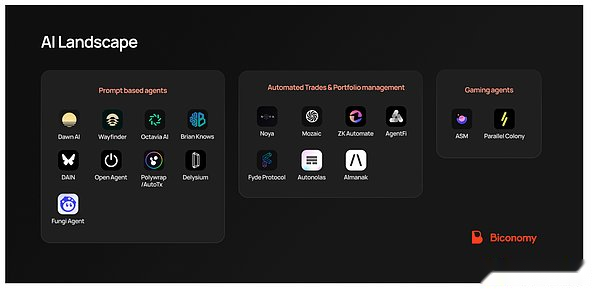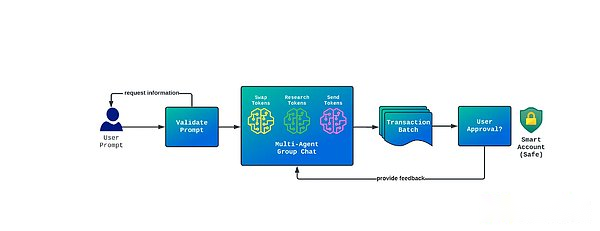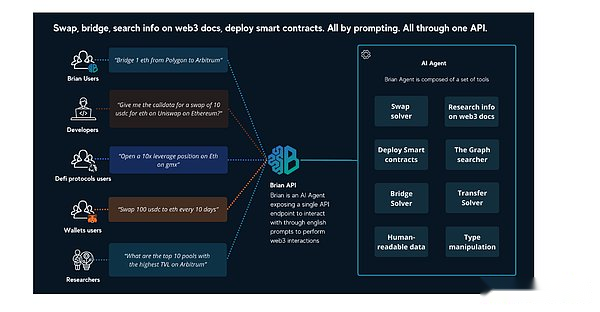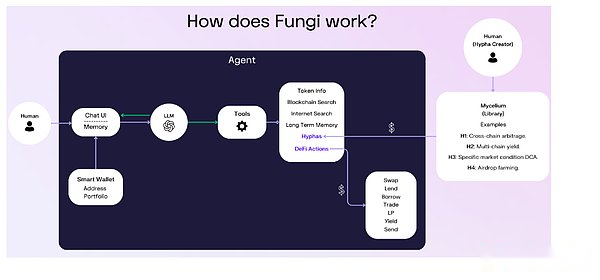
Author: nishil, Biconomy Member Source: biconomy Translation: Shan Oppa, Bitchain Vision
When we hear about the intersection of AI and cryptocurrencies, the main focus in this category is networks that address data collection, GPU computing, or data inference in the field of AI.These include Akash Network, Ritual net and other protocols.They stand out in the large AI industry by leveraging the decentralization, incentives, censorship resistance and privacy provided by web3.
While these projects are creating fascinating applications, their impact on everyday web3 users is still limited, and they are not effectively bringing new users into the web3 realm.
The rise of artificial intelligence agents
With the rapid development of Web3, new encryption protocols, tokens and applications continue to emerge.Dealing with this complexity is daunting even for the most experienced users.Therefore, there is a growing trend to create AI agents, which are smart assistants that can make the use of encrypted applications easier.Located at the intersection of cryptocurrencies and AI, these AI agents are designed to solve the difficult user experience (UX) problems in cryptocurrencies.Imagine the future, you just have to tell the AI agent what you want to implement on the chain and it will automatically write and execute the necessary transactions for you.
AI Agents will help us build smart layers on top of existing DeFi tracks.This layer will become the equivalent of bankers, investors, traders, fund managers, etc. in web3.They will use the underlying primitives for on-chain transactions.
DeFi-AI integration is expected to introduce advanced applications such as AI-driven lending, intelligent income farming strategies, automated market making and AI-assisted portfolio management.Use cases don’t stop there, AI agents can also play a role in the gaming industry, allowing users to have assistants and pets that help them navigate through games and enhance the overall user experience of the game.
Depending on the added value brought by the use case type and protocol, the evolving artificial intelligence proxy space can be roughly divided into the following categories:
Category of AI Agent

Game Artificial Intelligence Agent:
Teams such as Parallel Colony are building gaming AI agents to enhance the user’s gaming experience.These AI agents run in a Web3 environment and interact with players and game elements through on-chain smart contracts.Artificial intelligence agents are designed to act on behalf of users or as pets/assistants in the game.These agents are designed so that they can also interact with other agents and trade assets.
There are also some web2 and web3 games that are actively using AI to design dynamic non-player characters (NPCs) in the game.But for this article, we will only focus on AI agents that can trade and act on behalf of users.
Independent Portfolio Manager:
These AI agents can be used to manage asset pools from multiple different user profiles.The goal of AI agents is to maximize pool benefits by leveraging the correct off-chain AI data stream set to entrust assets to various DeFi strategies.It is essentially a portfolio management service that leverages the power of artificial intelligence.To ensure the minimization of the protocol’s trust, the project also enables ZK (through protocols such as Modulus) to provide on-chain proof of AI inference generated in the process.
Tips-based AI Agent:
Imagine the future, you just have to tell the AI agent what you want to implement on the chain and it will automatically write and execute the necessary transactions for you.
This is what most AI proxy projects are thriving, and we can imagine that future prompts may become the preferred way for ordinary users to interact with blockchain.
Projects such as Wayfinder, Brian Knows, Aperture Finance are developing interfaces similar to ChatGPT, which can help users conduct knowledge transactions directly on the blockchain through chatting with AI agents.These protocols utilize the power of LLM to convert user prompts and intents into executable transactions.
Let’s discuss some of these AI proxy protocols in detail:
Autonolas
Autonolas is a platform that can create and manage autonomous proxy services.These services are called proxy services, which operate independently off-chain as multi-agent systems (MASs) to achieve common goals in collaboration.In essence, Autonolas enables developers to build and deploy autonomous agents that collaborate seamlessly off-chain while leveraging blockchain technology to enhance on-chain capabilities.BabyDegen is one of such agents.
Here is the directory of other agents being built on the Olas network – https://pandora.computer/
AutoTX by Polywrap
Polywrap is building a dedicated AI proxy network that performs complex tasks for web3 users and protocols.These agents utilize crowdsourcing insights, off-chain and on-chain data sources, task planning, and batch transactions to effectively solve problems and make decisions in various areas.Current agents include payments, market research and transactions, social content management, forecasting and public product funding.Polywrap’s future plans include expanding the scope of professional agents, decentralizing their executive powers, and developing systems through community-driven governance.AutoTx is such an AI proxy.
AutoTx can convert advanced user goals into a series of blockchain transactions.This means you no longer need to be an expert on each protocol or spend hours learning how to manually form different types of transactions.Just tell AutoTx what you want to implement and it will handle the rest.

Parallel Colony
Parallel Studios is taking a new approach to AI agents with Colony, a brand new AI-powered Web3 survival game.In Colony, highly autonomous AI agents or “incarnations” constantly learn from the environment.Players must guide and cooperate with these avatars with different skills and abilities to survive in future earth with competing colonies.
Colony stands out for integrating continuous learning into its gameplay.Artificial intelligence incarnates learn from its own experiences, identities and goals to form a unique personality and worldview.Additionally, these avatars can manage digital assets independently through a dedicated Web3 wallet, allowing transactions with other in-game avatars.
White paper: https://paper.parallel.life/colony_paper_v1.pdf
Wayfinder
Wayfinder is creating a “map” for AI agents to handle tasks and simplify on-chain activities for users.By developing open source and incentivizing builders with $PROMPT tokens, Wayfinder will expand the navigation instruction network.Pathfinding will continue to enhance the capabilities of AI agents and make them smarter over time.It is designed to connect blockchain and off-chain data sources, allowing users to easily perform tasks via command prompts.Their innovations aim to make blockchain interactions more efficient and accessible, improving users’ lives by reducing complexity and stress.You will love this analogy and explanation from @tiggity_tc on Wayfinder.
This is the video of the actual operation of the wayfinding agent: https://x.com/AIWayfinder/status/1779605000735367549
white paper:
https://paper.wayfinder.ai/wayfinder_paper_v1.pdf
NOYA
NOYA is a decentralized finance (DeFi) protocol that enables artificial intelligence agents to safely and accurately manage the liquidity of multiple blockchains.It uses a composable system built from scratch, including a private Guardian network, AI-compatible oracle, and a competitive environment for AI and strategy managers.Noya has multiple vaults, each satisfying different user intent profiles.The protocol has its own artificial intelligence oracle designed to read various DeFi markets and pass information to the AI agent.
NOYA’s infrastructure uses advanced technologies such as zero-knowledge machine learning (ZKML) to support a variety of intentions such as liquidity supply, leverage management, and borrowing rate optimization.It aims to set new standards for full-chain liquidity management and financial strategies.The team is closely introducing access to the protocol.

Brian
Brian provides an API that developers can integrate into their applications so that users can pass their intentions with prompts like “Can you switch 10 usdc to eth on Uniswap on the Ethereum mainnet?”to generate web3 transactions.They also provide smart contract deployment services through prompts.On the backend, the team uses LLM to convert the prompt to a web3 transaction and then execute it through their preferred protocol and solver integration.
The team also built a Brian app that you can use to explore feature sets.The team hopes to expand their products by offering users regular and automatic payment settings options, among other things.

Aperture Finance
Aperture Finance completely transforms DeFi by providing liquidity management services through user-friendly protocols.It aims to enhance the DeFi user experience through an intuitive chat box interface inspired by GPT, allowing users to express their goals in natural language.Third-party actors (called solvers) handle requests by optimizing processes to ensure efficient and cost-effective execution.

Fungi
Fungi leverages the power of smart accounts and account abstraction to provide a self-hosted AI proxy experience.Fungi allows users to indicate command prompts through their interface, then process real-time blockchain data and perform operations independently according to user instructions.
Users can chat with Fungi, deepen their understanding of cryptocurrencies, receive personalized guidance, execute on-chain transactions, create customized DeFi strategies (Hyphas), and even monetize these Hyphas by sharing with the community.As a proxy network, Fungi interacts with each other and learns from past experiences, this is the financial super intelligence that everyone can use.
The working principle of Fungi is as follows:

Source: https://words.odisealabs.com/defi-ai
Fyde protocol
Fyde enables users to increase their cryptocurrency holdings faster by depositing into diversified, AI-managed vaults that lock in earnings and redistribute assets based on market performance and reduced volatility.
Users can deposit various tokens into these vaults and receive $TRSY, which is the token that represents their share of the vault assets.Fyde’s goal is to maintain consistent $TRSY liquidity under different market conditions, allowing users to trade easily.
The requirements of smart proxy for AI authentication layer
In all these upcoming AI and intent-related projects, potential use cases range from abstract simple tasks to empowering AI agents to execute complex DeFi strategies to find the best benefits.However, these AI agents face two main challenges:
-
They cannot truly achieve autonomy: Currently, AI agents can recommend on-chain operations and prepare transactions for users, but they still require users to sign or approve these operations.
-
If they choose to automate, they lose security: protocols tend to explore alternative solutions to automation, such as approvals, centralized vaults, shared private key pairs, which make the protocol a custody of assets and pose significant risks.
We need to provide guardrails for AI in the form of user-defined permissions—strictly define what operations can AI sign and what operations it does not have permission to sign.So we need a solution that can delegate transaction authorization to an AI proxy, but only with specific permissions and rules.









